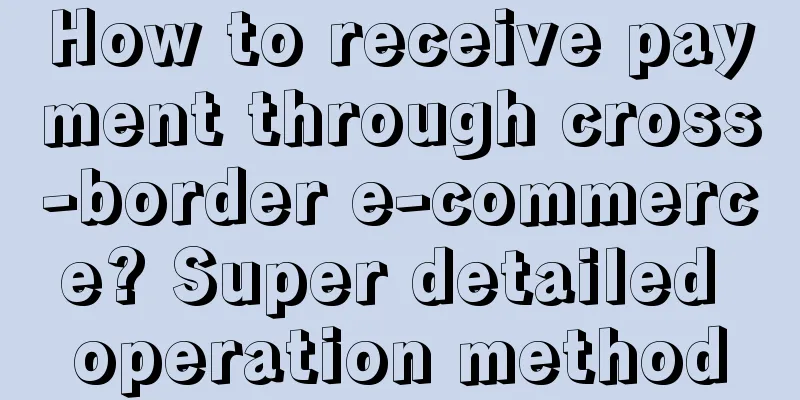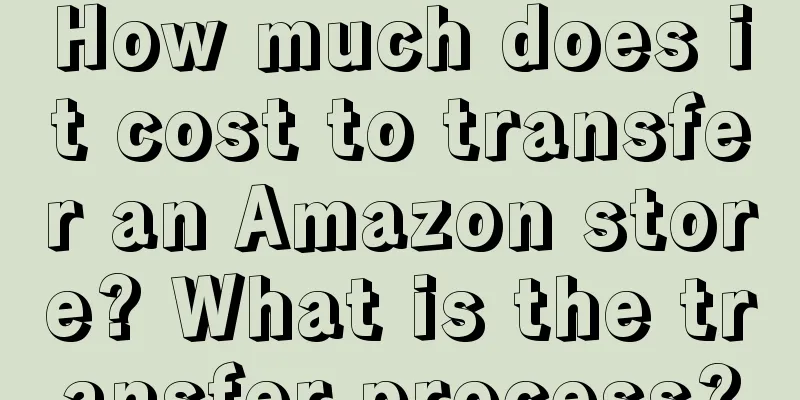How to receive payment through cross-border e-commerce? Super detailed operation method

|
As a way of starting a business, cross-border e-commerce can not only bring profits, but also expand the market. However, for cross-border e-commerce, how to collect payments may be an important issue. This article will discuss this issue and introduce the payment methods of cross-border e-commerce to help cross-border e-commerce accept payments smoothly and make profits. 1. How do personal cross-border e-commerce businesses collect payments? When accepting payments, individual cross-border e-commerce merchants can follow the following steps: Register a payment account: First, individual cross-border e-commerce needs to register a suitable payment account in order to accept international payments. Common payment accounts include PayPal, Stripe, Skrill, etc. Set up payment methods: In the payment account, individual cross-border e-commerce needs to set up their own payment methods. This usually includes bank transfer, credit card payment, e-wallet, etc. Provide payment information: Depending on the payment method selected, individual cross-border e-commerce merchants need to provide corresponding payment information, such as bank account number, credit card number, etc. Generate a payment link or QR code: After completing the above steps, individual cross-border e-commerce users can generate a payment link or QR code through their payment account and embed it into their own online store or electronic invoice to facilitate payment by buyers. Confirm payment: After the buyer completes the payment, the cross-border e-commerce merchant needs to confirm the payment. This usually involves checking the payment record of the payment account and verifying and confirming each payment. 2. What are the payment methods? Individual cross-border e-commerce merchants can choose from a variety of payment methods, depending on the country and region, the type of products sold, and personal preferences. The following are some common payment methods: PayPal: As one of the world's most well-known online payment platforms, PayPal is widely used in cross-border transactions and supports multiple currencies and payment methods. Bank transfer: Individual cross-border e-commerce merchants can provide their own bank account information and allow buyers to pay through bank transfer. This method can directly transfer funds to personal accounts. Alipay: Alipay is a common payment method in the Chinese market. Individual cross-border e-commerce merchants can register and bind their own bank cards to facilitate buyers to pay using Alipay. Credit card payment: Through cooperative payment institutions or banks, individual cross-border e-commerce can accept buyers to pay by credit card. This method is convenient and fast, and can provide a better payment experience. E-wallet: In addition to PayPal and Alipay, there are other e-wallets to choose from, such as Stripe, Skrill, etc. Individual cross-border e-commerce can choose the appropriate e-wallet based on buyer preferences and regional characteristics. It should be noted that different payment methods may have their own fees and operating procedures. Individual cross-border e-commerce businesses need to make comparisons when choosing and consider their own needs and customers’ payment habits. Through the above introduction, we know the methods and common payment methods of individual cross-border e-commerce. Individual cross-border e-commerce can register a suitable payment account and set up their own payment methods. Common payment methods include PayPal, bank transfer, credit card payment, Alipay and other e-wallets. Recommended reading: Which platform should I choose for my personal cross-border e-commerce business? What are the requirements for entry? How much does it cost for personal cross-border e-commerce? Do I need a deposit? Can cross-border e-commerce personal trademarks be registered? What are the regulations? |
<<: How to open a store for a cross-border e-commerce novice? A complete tutorial on opening a store
Recommend
Douyin Double Eleven, anchors "share" Li Jiaqi
It’s the Double Eleven Festival on Douyin again. H...
Can Amazon Prime exclusive discounts and coupons be used interchangeably?
Amazon often launches events. In addition to the e...
Short dramas in 2025: free, high-quality, and competing for IP
In 2024, the short drama market has experienced ex...
In 2024, traffic will coexist, the public domain will build scale, and the private domain will seek compound interest!
The author of this article focuses on the view tha...
With monthly sales of 500 million and a return rate of over 90%, their business has become the top streamer on Douyin
Jewelry merchants occupy five of the top ten spots...
Send Meituan a bullet
On February 11, JD.com announced the launch of a &...
Traffic + subsidies + global coverage: why does Douyin e-commerce attach so much importance to "key promotion products"
This year, consumers' demands have begun to ch...
The Internet celebrity with 40 million fans was scolded and cried, and the national cultural and tourism war went crazy
As the Spring Festival travel season approaches, t...
The short drama industry welcomes new forces. How do the old big companies stir up the trillion-dollar market?
The short drama industry has recently ushered in a...
In this environment, how can we demonstrate the value of data analysis?
How to reflect the value of data analysis in a sce...
Do I need to pay taxes for Amazon’s overseas direct mail? What are the modes?
If you shop through an overseas purchasing platfor...
What are the payment methods on Amazon? What are the payment methods?
If we want to shop online, we must first understan...
How to connect Wish Logistics? How to solve the logistics problem?
With the booming development of the e-commerce ind...
How do I turn off Amazon Remote Delivery? Where can I set it up?
Amazon's stores are overseas businesses, so in...
Is it easy to do cross-border e-commerce in Russia? Introduction to cross-border e-commerce platforms
Now is the era of globalization. Some friends want...









